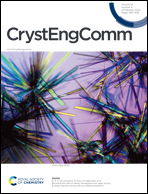Syntheses, crystal structures and supramolecular assemblies of two Cu(ii) complexes based on a new heterocyclic ligand: insights into C–H⋯Cl and π⋯π interactions†
Abstract
A new heterocyclic ligand, N3L [4-(1-methylimidazole)-2,6-di(pyrazinyl)pyridine] has been synthesized and characterized by several spectroscopic methods. The ligand (N3L) was then used for the preparation of two complexes, namely, [Cu(N3L)Cl2] (complex 1) and [Cu(N3L)(Cl)(μ-ONO2)]n (complex 2). The crystal structures of these complexes have been established by single-crystal X-ray diffraction analysis. Complex 1 is a mononuclear one whereas complex 2 is a 1D coordination polymer. The structural insights reveal that non-classical hydrogen bonding (C–H⋯Cl, C–H⋯O, C–H⋯N) and π⋯π stacking interactions play a crucial role in stabilizing various supramolecular architectures of the title complexes in the solid state. All the non-classical hydrogen bonding interactions are quantified through the infographic 2D fingerprint plots. Additionally, theoretical calculations (density functional theory) were carried out for both complexes to analyze these non-covalent interactions in the solid state including their characterization using Bader's theory of atoms in molecules and the noncovalent interaction (NCI) plot index.



 Please wait while we load your content...
Please wait while we load your content...